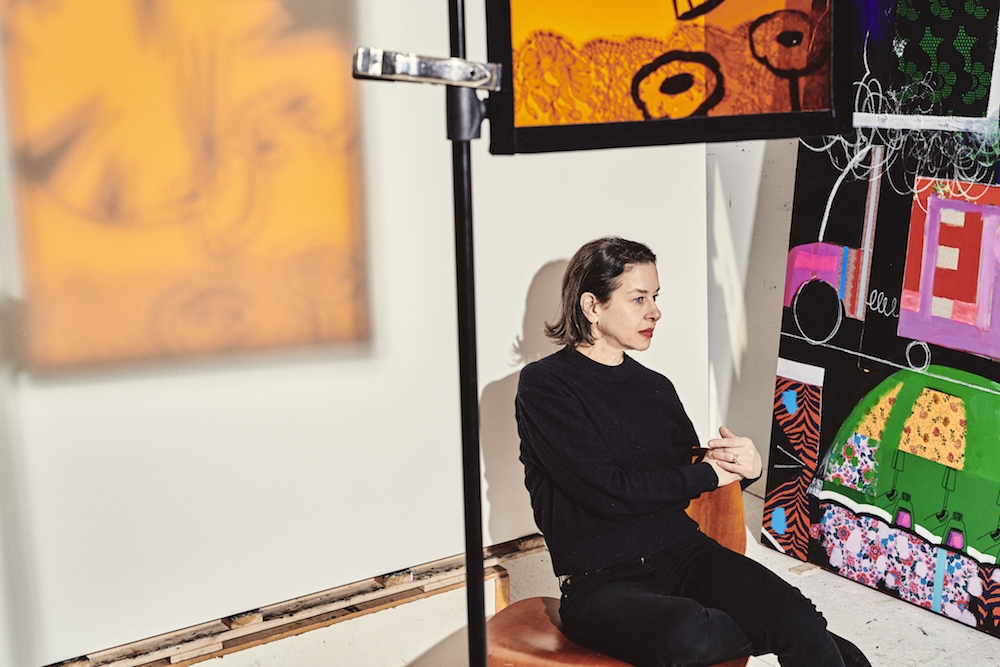Ellen Berkenblit
Practical Magic
Interview by Kristin Farr and portrait by Bryan Derballa
Letters have faces and fingers could be figures. What is recognizable in Ellen Berkenblit's paintings is beside the point. The tigers and fingernails are her vocabulary. Ellen eliminates the levels between consciousness and the sublime, frequently finding that elusive, painterly trance. Her marks are spontaneous, physically-driven, and layered continuously until the images rise to the top, nearly subconsciously, but straight from her soul. With Ellen as a conduit, gestural signatures unfold, not without thought, but without barrier or hesitation. She stays the course.
Magic is an act that conjures something out of nothing, and cannot be defined by religion or science. “Practicality and magic are two of my favorite modes,” Ellen states, plainly, explaining that she doesn't waste time or fuck around when it comes to the fervent and alchemical surprises of paint.
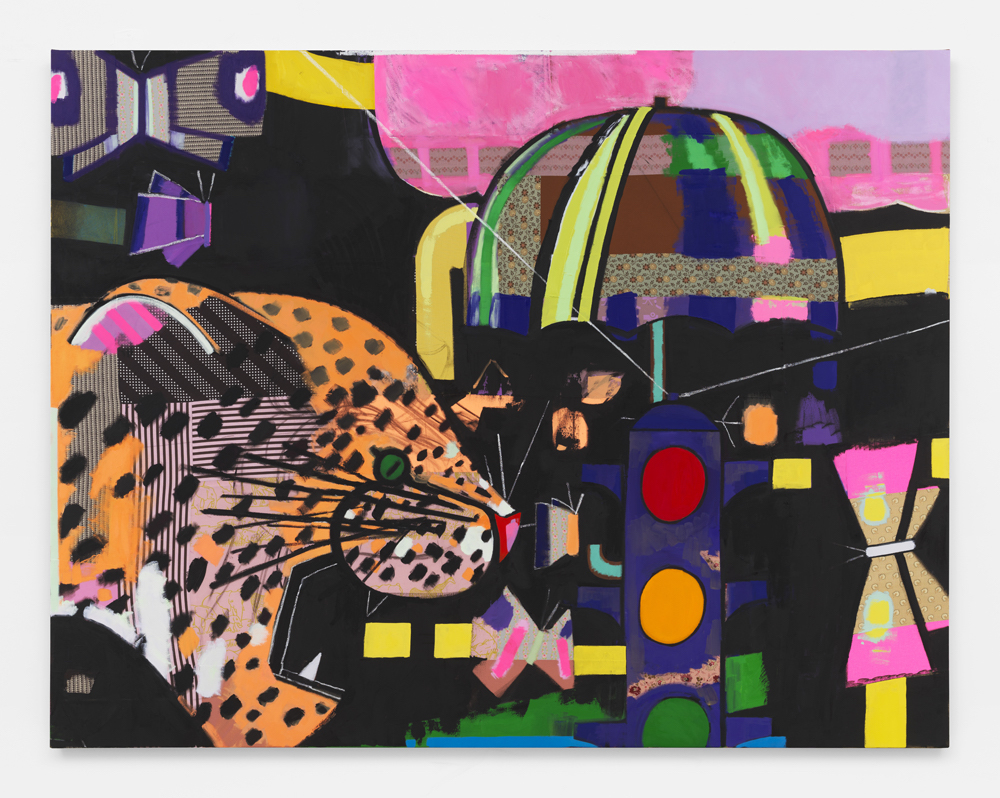
Kristin Farr: What are you working on right now?
Ellen Berkenblit: A painting on calico. I stitch together fabric with different patterns and colors. It's like a spontaneous drawing with fabric, but resembles a quilt. It gets stretched and prepped for oil paint, and then it's a whole new puzzle that is familiar but looks quite different as a canvas. I prepare a lot of them at once, and start visually figuring out some sort of puzzle. I have no predetermined approach to any of the canvases, calico or linen, I just go ahead.
Sewing is a nice balance to painting.
They are very interchangeable somehow in my mind. I was a seamstress for my job for many years, and I get lost in sewing and painting in a similar way. It's another way of drawing with fabric and color.
I've had one sewing machine for so long, and I know it so well, and it feels like I'm driving a car down a familiar path to home. It's very second-nature. I live in New York, so I don't have a huge sewing room, but I do have a little one, and that's pretty lucky. But I can't even see what I'm doing in terms of viewing a whole calico piece at once. It's very section-by-section, and that's similar to the way I look at my paintings. Most are quite large, so I can't see the whole thing at once while I'm working on it.
What kind of fabrics are you drawn to?
Colors that speak to me; a lot of them are very flowery. But some are just plain old stripes, or tiger print, and I also print my own fabric where I enlarge small sections of clip art, let's say a camera or a fingernail getting polished, and I have them digitally printed. I incorporate that into the fabric canvases as well.
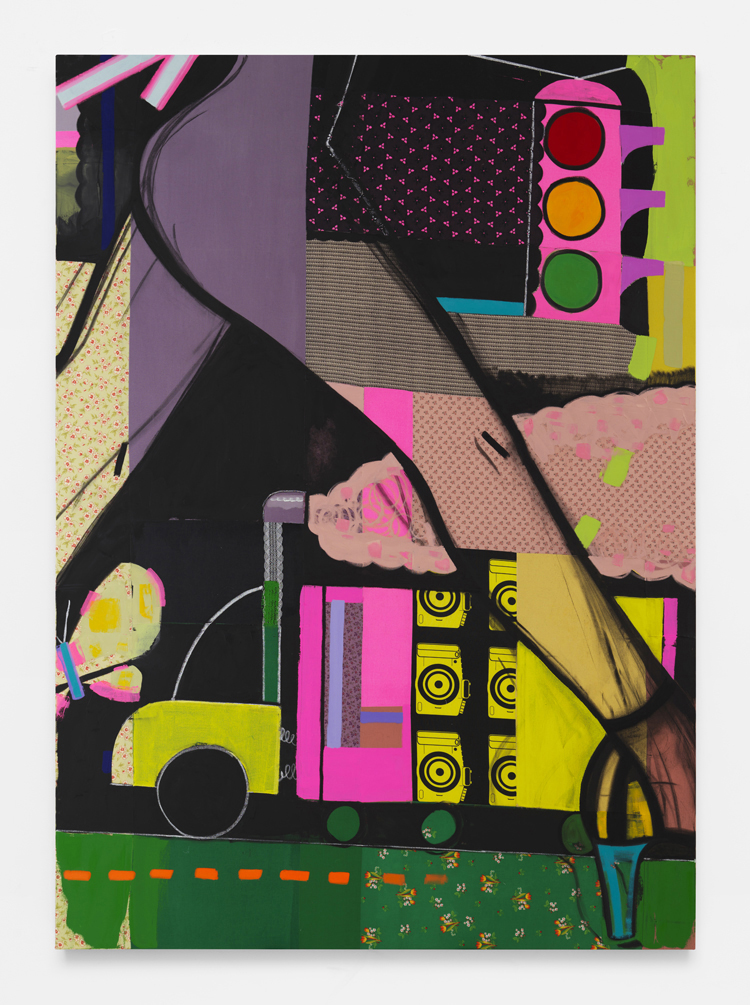
What did you make as a seamstress?
Mostly dresses. I used to go out way too much in my twenties, as lots of people do, and I had absolutely no money, and was also a really good sewer and could design things that I could wear. I just made all my dresses myself and, eventually, people would ask where I got them, and that became how I made money. It expanded into lingerie, and some wedding outfits, and other miscellaneous, weird things. I was able to sew in my kitchen and paint in other parts of my tiny apartment, and somehow, all together, it was my job.
Do you have synesthesia?
Perhaps, yes, I probably have it. I don't have the type where you associate a number with a color, but I have a lot of integration and porous boundaries between smell, touch, taste and the visual. For instance, colors have a flavor to me as I use them. Touch and my physicality determine line, which is tactile, but also visuals and colors can have smells, and names or words have flavor to me.
That's the more rare form of synesthesia.
It's almost like having empathy. Like when looking at a color, one can empathize with it so much, one gives it a personality, rather than an anonymous color. Yellow becomes a friend and you imagine the sound it makes when it talks.
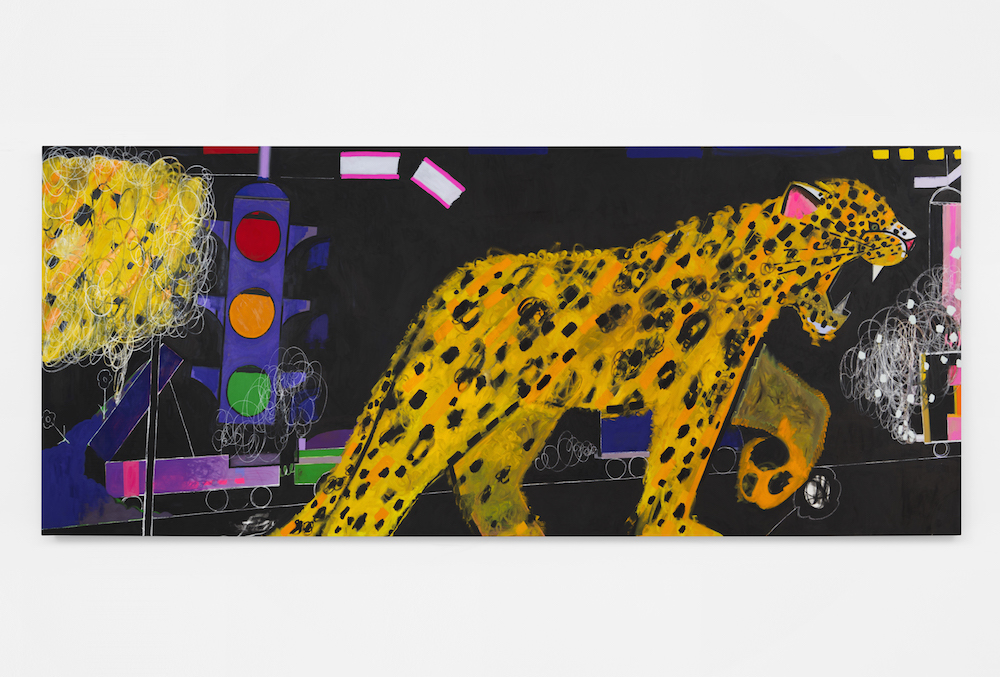
People crave color. I enjoy talking about it.
I do, too. I think my paintings emerge through color. They emerge through a few different things, but significantly through the language of color and what is happening at the moment on the palette. The colors are almost the domino effect of going through a painting. One leads to the next, edges between colors interact in a way that inspires me onto the next passage or mixing of colors. I spend a lot of time mixing colors on my palette before I even put them on the surface. Mixing is a constant throughout the process, the jumble of ideas that flow through color affects my relationship to them, and how they react with each other, and that always surprises me. They don't do one thing. They're full of surprises.
Do you have one color that's been with you a long time?
There are colors and variations on them that I have used my whole life. Even as a young kid, I used a lot of green paint. I liked sour things, and I still use a lot of green. Over the years, I'll find a new type of paint or pigment that will suddenly shift everything. It's like tuning an instrument. It can shift everything into another tune, even the green. So, yes, my colors morph, but they always come back after years. They never go away.
I was looking at your largest painting, and noticed how you used purple to convey the side of a stoplight at night. It was so subtle but stuck out to me.
People quite often ask where these things that I paint come from, and if they mean something; quite frankly, I think the stoplight is a classic case of things that cross my path as I'm walking. I have a 25-minute walk to my studio, and everything I pass tends to creep into the paintings. I've lived in New York nearly my whole life, and, for some reason, the stoplight only recently crept in. But most of the other things that show up emerge from my feeling of physicality as I paint. It's as if the energy I feel as I'm painting will create the curves and lines that are very interchangeable, so a leg could be a truck, or an umbrella, or a woman's profile, and they seamlessly interchange for me.
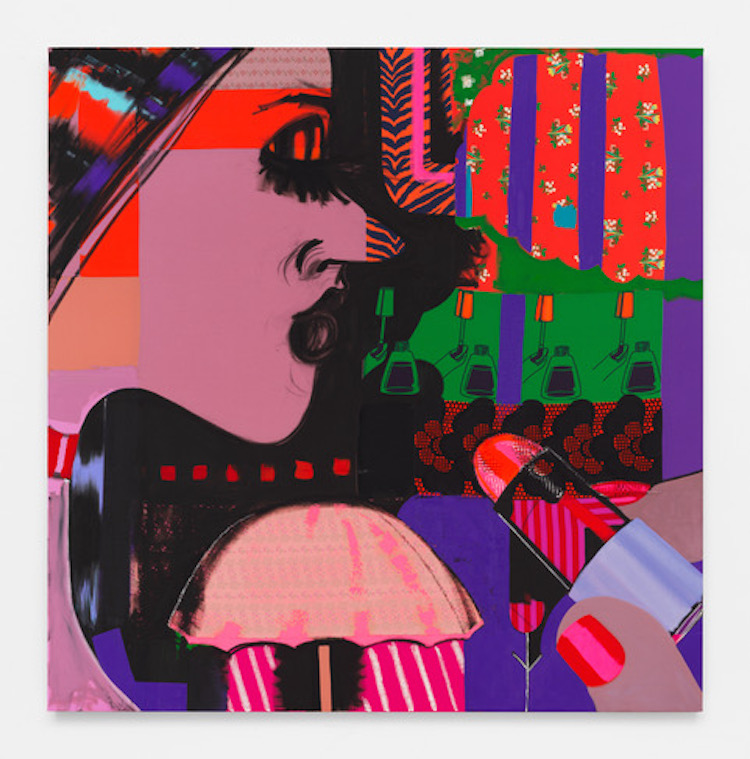
And you like painting in solitude.
Yes. The only time I painted with people around was to make a video called Lines Roar. I love to be alone and I always have. I haven't changed much since my youth in terms of what makes me feel comfortable, and the way the pipeline into my inner self works best when I'm by myself.
I stay in the studio all day, and I have coffee here, and I only have to leave to use the bathroom down the hall, and sometimes, even that feels like an interruption. I'm in my PJs basically, mentally and physically. The studio is bedroom-y. As much as I like to be alone, I'm actually a hermit who loves people. Not everyone, but you know what I mean.
Maybe we'll title this interview, A Hermit Who Loves People.
That'll fly off the stands.
I already planned to call it Practical Magic, because you've said you are a practical person, and your paintings are magical. What is your definition of being practical?
I think it's feeling mortal, and not wasting things, meaning materials or time. I have so many ideas in my head, and there are so many paintings I want to make, so I feel I have to create this very practical setup so I can do it with as little interruption as possible. I try to be as straight of an arrow as possible, and not fuck around too much. It almost sounds boring, but I don't ever feel bored.
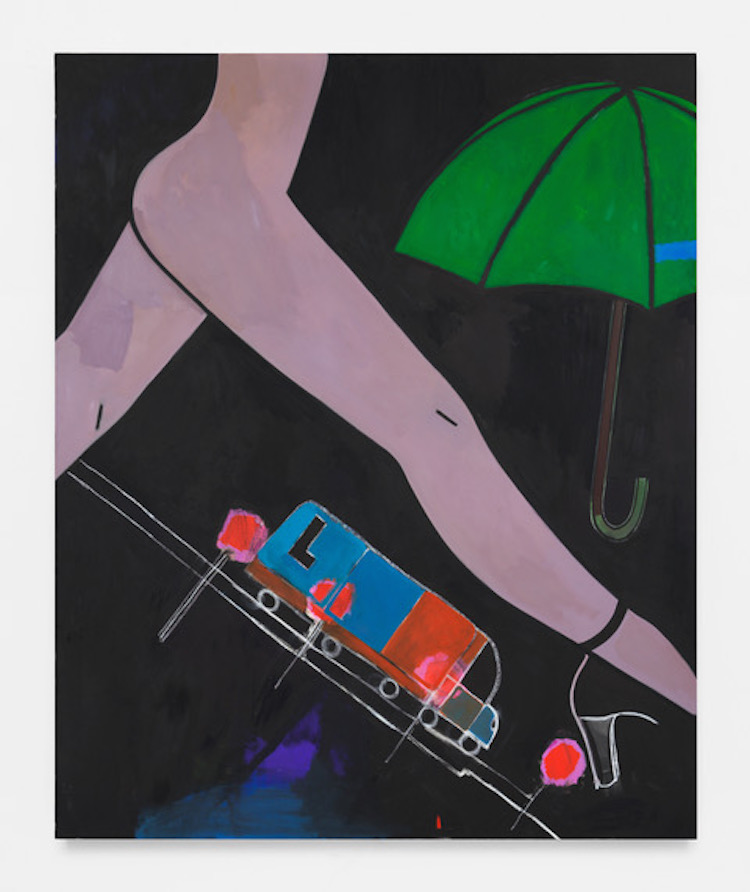
You have a mission.
I have a mission. Yes.
When you look back at your paintings, do you remember exactly what was happening in your life at the time?
Completely. Like photographs, paintings bring me back to that moment in time, and that's why sometimes it's hard to look at a box of photographs, or older paintings, because it's a lot of information. It all comes flooding back. I had a show at Anton Kern Gallery last September that was works from all different times in my life, including a drawing I did when I was 11 or 12, and it was good, even though it was very uncomfortable for a moment. And then it became liberating to have those days paraded in front of my eyes, from different points of my life, and the cool thing was how much my work had changed, and how little it had changed. And, to wit, the drawing I did when I was 12 is a profile of a witch, and it's very typical of what I have always done, and in that way, nothing has changed. The kernel of myself feels very unchanged, and I got to see that when I put all that work up together. Every little cell in our body stays the same, and obviously we grow alongside of it, but the kernel is still there.
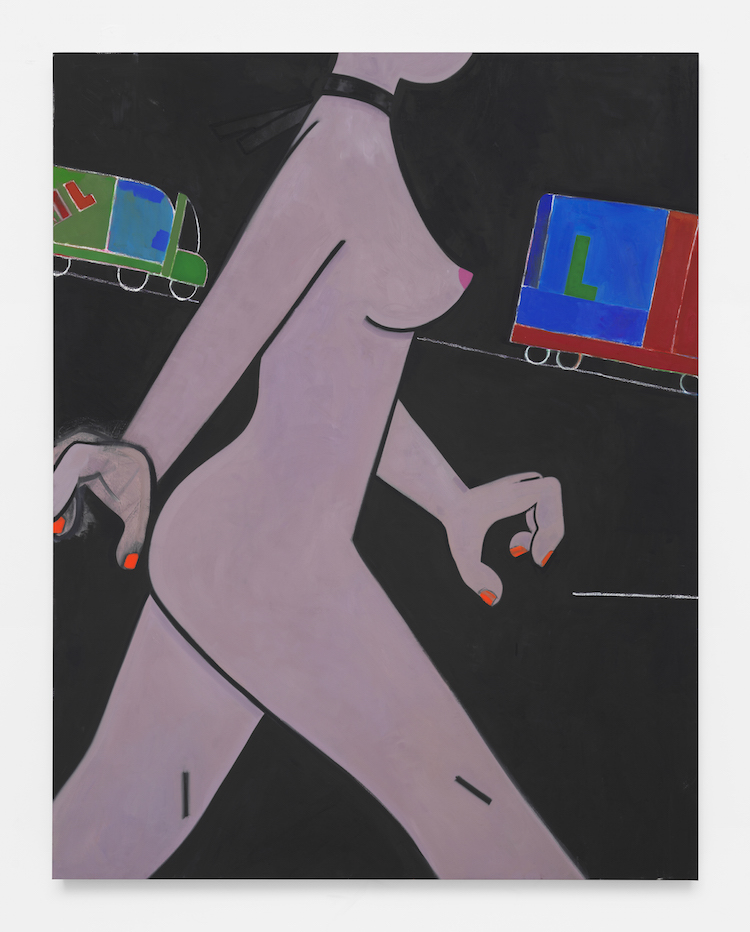
There are large swaths of black across of your paintings, and I always wonder what's underneath.
There's a lot, especially behind the black, but even behind all the other colors. I don't know what I'm doing when I start a painting. I'm riffing on what's happening, and things get bulldozed over; shapes change. Things get turned upside down and redrawn. There's a lot of activity that comes and goes in the making of the paintings. There are many layers, and I think there is a forcefulness in obliterating what isn't working within the painting. This has to do with my practical side. I just keep working on a painting until it's right, whatever that means.
I don't keep paintings around that I don't like. I just keep painting until I fall in love with it. Instead of storing a lot of canvases that are OK, those drafts are all stored within the layers of one painting. I also believe that all the activity is what creates the final thing. It had to be borne of the activity that's underneath it. It's like an armature.
Are you left-handed?
I am. How'd you know?
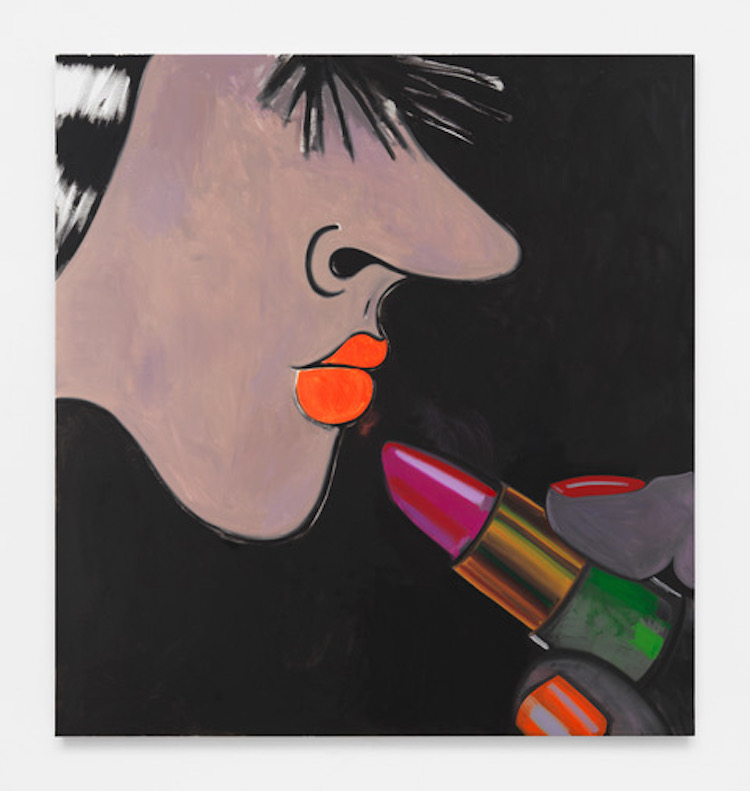
You know... investigative journalism. Only 10% of people are left-handed.
I really like being left-handed. I don't know why. It probably affects how my work looks, or how my mind goes, and now that I'm accepting of myself, I'm thinking, OK, my left hand had something to do with things.
Most of your figures face to the right! But you're left-handed.
That's so funny. I do always have everything facing to the right. I don't know why, but I go with it, because painting, to me, is like writing words. It's just as natural to me as writing, and I feel like my painting is my handwriting. I'm not really making a picture in my mind when I'm painting. If I'm letting everything happen naturally, it's going to face to the right. I don't know if that's connected to being left-handed, or obsessively comfortable with a certain handwriting that I use in my work.
Or maybe because we read English left to right?
Now that you bring that up, I studied Hebrew as a kid, which goes from right to left. I went to Hebrew school and wrote in Hebrew and English until I was 13, which probably helped me feel comfortable with lines, letters and shapes being interchangeable.
To me, all letters have a face on them, including the whole cast of Hebrew letters, too. When I paint a female, or a lipstick tube, or a hand, I'm not really imbuing it with a strict, one-read purpose. In the same way as letters, it can take on other persona or characteristics.
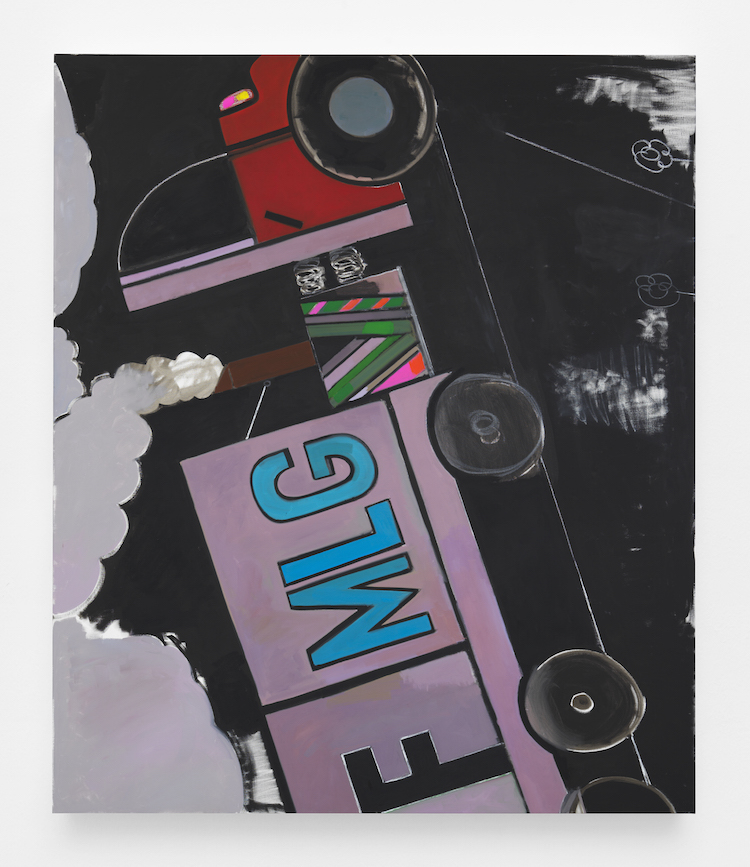
I was just noticing a hand you painted that made me think of a letter shape. And the way you wield a brush seems calligraphic.
I've been painting trucks, and often they have letters on them, and people will ask what they mean, and they're based on the shape and personality of the letter, as opposed to being initials.
Your own name has a personality and repetition of shape.
That is so lovely that you said that. I think my name looks like me when I write it in cursive. When I was very little, my mother had silver hair clips for her curlers, and the brand she used was called Lady Ellen, which was written in script.
It's all loops.
It's all loops! Even just writing my name, and being given that name, caused my line to look how it does now.
Cursive was formative.
I love cursive. I've heard that it's not being taught anymore. It's part of what made me fall in love with line at an early age. I wonder what will happen when we don't use handwriting anymore, 100 years from now. I don't think it's necessarily horrible, because things change with progress and technology, but it does affect us physically, and how our minds work, so I'm just curious how the absence of cursive will make people think differently. It's a basic, primal movement to write.
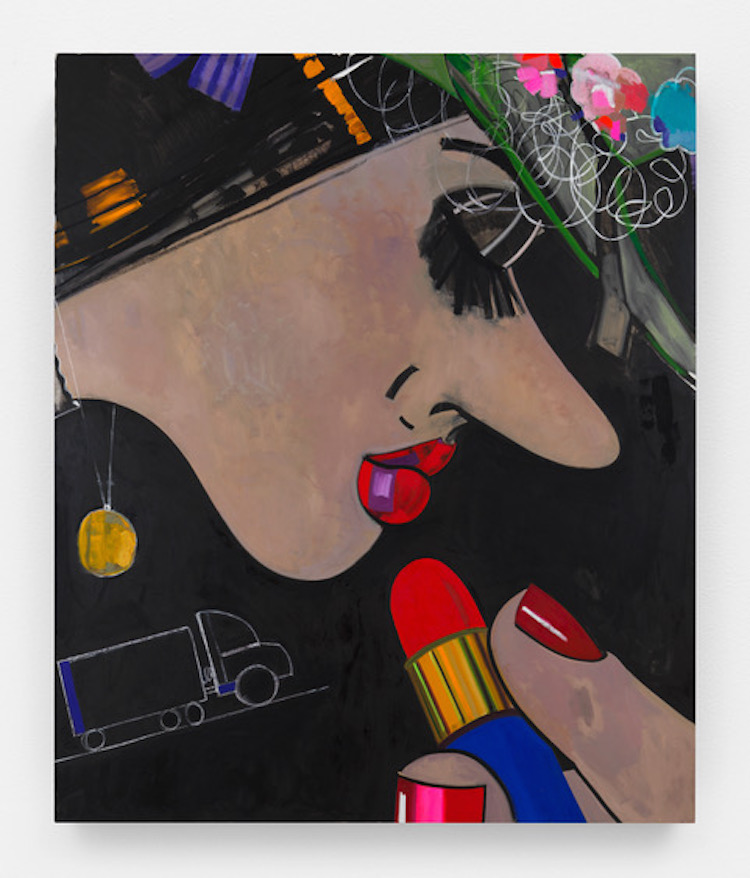
My hand doesn't have as much stamina for handwriting these days. Speaking of stamina, you are very in-shape as a painter. You log many hours and your practice is fit and muscular. Does it feel like it's a performance in the studio?
It feels like a dance. I hate saying it, but it does. It feels athletic, which sounds less romantic and more true to what I mean. I feel like it's an athletic activity for me to paint, not for everyone. The physical movements of what I'm doing, whether it's getting up and down a ladder, or stretching my arm or leg to reach something, it informs the work, and in that way, it's very athletic, and I'm a very physical person when I'm making the work, and in general.
You paint in very large scale.
I think about the way people’s brain waves change when they exercise, or when they pray or bow, all those things that are physical and part of our life. Getting physically kind of tired, and also energized, impacts the work. Museum of Contemporary Art Chicago's windmills.
Why do you think you focus on zoomed-in details?
I don't know why. There's something exhilarating about it for me and that's the closest explanation I can have for it.
I always think about the simplest gesture possible to communicate something. I can't draw, but I can probably make a doodle that resembles a polar bear if I have white paper.
That's drawing to me. Drawing is communicating, not necessarily being able to render something. To me, communicating an idea through drawing—that's magic. One has conjured something that reads and speaks. Sometimes it's just very zen and to-the-point. I love comics for that reason. My work is not an homage to comics, but my work has a similar love of the economy that comics generally need because of the printing process.

Back to the magic... putting so much physical energy into something handmade gives it some kind of power.
It’s the idea of Frankenstein, how something gets made or comes alive out of basically nothing. Globs of paint—but you can conjure them into life.
Your paintings cast a spell.
They’re only good spells if so.
You’re a good witch.
Definitely. I hope so.
I know your father's photography was an influence and you grew up with a darkroom in the house. Seeing your paintings reveal themselves has a connection, that magic moment of the image appearing.
Right, that search, and then it's emerging from the murky background. It was not only my father's photographs that were influential, but our personalities were so similar. And that's no accident, because obviously we have the same DNA. He liked to be alone. He liked to be able to shut the door and be in a dark room, and have the hours fly by without being part of the outside world. Our personalities being similar shaped my life, and my mother was a school teacher who influenced me equally. And it all went into my artwork, even though my parents weren't artists in the traditional sense, but they were in their own way. My father was mixing stuff up in a laboratory, which is what an artist does.

